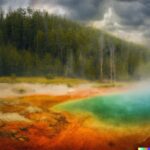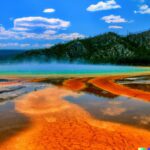Are you curious about the unique geothermal features found in Yellowstone National Park? From stunning geysers and hot springs to potential dangers and safety tips, this article covers everything you need to know about the park’s fascinating natural wonders.
Discover how these geothermal features are formed, what makes them so unique, and how visitors can safely enjoy them. Whether you’re planning a trip to Yellowstone or simply interested in learning more about its geology, this article has you covered.
What Are Geothermal Features?
Geothermal features refer to natural formations resulting from hydrothermal activity and the interaction of volcanic and geological processes. These features are often characterized by thermal pools and unique geological formations.
Geothermal features, such as thermal pools and geysers, are formed by hot water and steam rising from the Earth’s interior. This interaction with surrounding rocks creates visually stunning landscapes. The deposition of minerals through this hydrothermal activity contributes to the diverse colors and textures found in these areas.
The development of these features showcases the powerful forces at play beneath the Earth’s surface, offering an awe-inspiring display of natural energy and geological processes.
How Are Geothermal Features Formed?
Geothermal features are primarily formed through the complex interplay of geological formations, geothermal resources, and thermal springs, resulting in the manifestation of unique geothermal phenomena.
Geological processes involve the movement of molten rock, known as magma, beneath the Earth’s surface. This magma heats underground water reservoirs, creating pressure that forces superheated water to rise towards the surface. This results in the characteristic thermal springs and geysers associated with geothermal features.
As time passes, minerals from the heated water are deposited, further shaping the landscape and contributing to the diverse geological formations found in geothermal regions. These dynamic interactions between geological elements and geothermal resources continually influence the formation of these fascinating natural features.
What Are the Geothermal Features in Yellowstone National Park?
Yellowstone National Park boasts an array of captivating geothermal features that stand as natural wonders and prominent tourist attractions, showcasing the park’s unique geothermal attractions.
The park’s geothermal features include colorful hot springs, bubbling mud pots, and iconic geysers such as Old Faithful, which draw millions of visitors annually.
These attractions not only offer a glimpse into the Earth’s powerful forces but also provide a habitat for unique thermophilic microorganisms. The geothermal wonders of Yellowstone are a testament to the park’s geological significance and contribute to its status as a must-visit destination for nature enthusiasts and tourists alike.
Geysers
The geysers in Yellowstone National Park are mesmerizing manifestations of geological processes, characterized by captivating geyser eruptions within distinct thermal areas.
Yellowstone National Park is home to incredible geological wonders, fueled by vast underground reservoirs of hot water. This water is heated to boiling point by the intense heat from the Earth’s mantle.
As the superheated water rises to the surface, it encounters obstacles, creating pressure that results in spectacular geyser eruptions. Each thermal area within the park boasts its own unique geyser features, contributing to the diverse and fascinating landscape of Yellowstone.
Hot Springs
The hot springs of Yellowstone National Park stand as geothermal wonders, showcasing remarkable mineral deposits and distinctive geothermal formations that captivate visitors with their natural beauty.
Their mesmerizing hues, ranging from vivid turquoise to deep sapphire, create a stunning contrast against the surrounding lush greenery.
The bubbling, steaming water emerges from the earth, carrying with it the ancient history of the land, while the vibrant microorganisms thriving in the extreme conditions add an otherworldly charm.
It’s not just a sight to behold, but a living testament to the incredible forces at work beneath the surface of the Earth.
Fumaroles
Fumaroles in Yellowstone National Park emit mesmerizing steam plumes, originating from hydrothermal vents linked to the park’s geothermal reservoirs, creating captivating natural spectacles.
These impressive features are an integral part of the park’s geothermal landscape, contributing to the dynamic and ever-changing environment. The steam plumes, rising elegantly into the sky, showcase the raw power and energy that lies beneath the earth’s surface.
Yellowstone’s fumaroles serve as a reminder of the park’s volcanic past and its ongoing geologic activity. Visitors are drawn to these enchanting displays, gaining a deeper appreciation for the forces at work within this remarkable natural wonder.
Mud Pots
Yellowstone’s mud pots, featuring hydrothermal features, symbolize the park’s dynamic geothermal environment and serve as prime examples of its diverse geothermal systems, offering visitors compelling natural experiences.
These mud pots are renowned for their visually striking and ever-changing landscapes, where the interaction of hot water and volcanic gases creates colorful and captivating displays.
The bubbling mud, steam vents, and the distinct odor of hydrogen sulfide emanating from these features provide a sensory representation of the park’s geothermal activity, giving visitors a profound connection to the Earth’s inner workings. Their presence highlights the unique and constantly evolving nature of Yellowstone’s geothermal systems, enriching the park’s scenic and educational qualities.
What Makes Yellowstone National Park’s Geothermal Features Unique?
Yellowstone National Park‘s geothermal features hold uniqueness in their association with geothermal energy, distinct geothermal landscape, and the presence of rare and extraordinary geological formations, setting them apart as unparalleled natural marvels.
Yellowstone National Park boasts a one-of-a-kind landscape, thanks to its position above a supervolcano. This creates a constantly changing energy dynamic, resulting in stunning geothermal features. These include vivid hot springs, lively geysers, and bubbling mud pots, all showcasing the raw power of the Earth.
But it’s not just the typical geothermal features that make Yellowstone special. The park also boasts rare geological formations like travertine terraces and hydrothermal explosion craters, highlighting the truly exceptional nature of this natural wonder.
Is Yellowstone the Only Place with Geothermal Features?
Yellowstone National Park stands out for its remarkable geothermal resources and captivating features. However, numerous other locations worldwide also exhibit geothermal activity, contributing to ongoing exploration and the harnessing of geothermal power.
Geothermal features can be found on various continents. From the geysers of Iceland and New Zealand to the hot springs in Japan and the geothermal fields in the Philippines.
The global appeal of geothermal power is apparent. Countries like Kenya and Indonesia actively utilize this renewable energy source for electricity generation and heating. This widespread exploration and implementation demonstrates the growing recognition of geothermal energy’s potential to contribute to sustainable and resilient energy systems worldwide.
What Are the Dangers of Geothermal Features in Yellowstone National Park?
Visitors to Yellowstone’s geothermal features must be mindful of potential dangers, necessitating adherence to stringent geothermal safety regulations and guidelines to ensure a secure and enriching experience.
The dynamic nature of geothermal features in Yellowstone poses risks such as scalding hot springs, unexpectedly fragile ground, and toxic fumes.
Following designated boardwalks and trails, respecting barriers, and heeding warning signs are imperative to prevent accidents.
It’s crucial to stay on designated paths to avoid the unstable ground, and to keep a safe distance from the thermal features to prevent injuries or environmental damage.
By responsibly following safety measures, visitors can appreciate the natural beauty of Yellowstone while minimizing the inherent risks associated with its geothermal features.
Contact with Hot Water or Steam
One of the primary dangers within Yellowstone’s geothermal areas involves the potential contact with scalding hot water and steam emanating from the park’s captivating steam vents, necessitating caution and awareness among visitors.
Steam vents in geothermal zones can reach extreme temperatures, posing a significant risk of severe burns for visitors who get too close. The unpredictable nature of these phenomena highlights the importance of staying on designated paths and remaining vigilant.
It’s crucial to pay attention to warning signs and respect safety barriers in these areas to avoid potentially life-threatening encounters with hot water and steam.
Ground Instability
The geothermal areas in Yellowstone may exhibit ground instability, stemming from geological processes, thereby necessitating vigilance and compliance with safety measures to mitigate associated risks.
This instability can result from the movement of magma beneath the Earth’s surface, creating pressure that impacts the stability of the ground.
The presence of hot springs and geysers can lead to changes in the terrain, making it essential for visitors and authorities to be aware of potential hazards.
A thorough understanding of these geological processes and regular monitoring of the geothermal areas are crucial to ensuring public safety and preserving the natural beauty of Yellowstone.
Toxic Gases
The presence of toxic gases within Yellowstone’s geothermal regions poses potential hazards, linked to the park’s hydrothermal activity, necessitating visitor awareness and preparedness to ensure safety.
The release of toxic gases, such as hydrogen sulfide and carbon dioxide, is a direct result of the underground hydrothermal systems that characterize Yellowstone.
Visitors must recognize the signs indicating the presence of these gases, including the distinct smell of sulfur and the observation of dead or wilted vegetation.
Understanding these warning signals is crucial for visitors to take immediate preventive actions, such as moving to higher ground when necessary, to mitigate the associated risks and ensure a safe and enjoyable experience in the park.
Human Interference
Human interference within Yellowstone’s geothermal areas poses a significant threat to the preservation of these delicate ecosystems. This necessitates comprehensive management and preservation efforts to safeguard their integrity.
Interference from human activities can disrupt the natural balance of Yellowstone’s geothermal wonders. This can have detrimental effects on the unique flora and fauna that thrive in these environments.
Human activities, such as waste disposal and unregulated foot traffic, can alter the delicate pH balance of the hot springs and geysers, causing irreversible damage. To preserve these areas for future generations, it is crucial to prioritize conservation measures and responsible tourism practices.
How Can Visitors Safely Enjoy Yellowstone’s Geothermal Features?
Visitors to Yellowstone can indulge in the mesmerizing geothermal features while ensuring their safety through responsible geothermal tourism and active participation in conservation efforts, ensuring a secure and enriching experience.
This approach not only allows visitors to appreciate the natural wonders of geothermal activity but also fosters a sense of responsibility towards preserving this fragile ecosystem.
Engaging in conservation initiatives ensures that future generations can continue to witness the spectacular geysers, boiling hot springs, and vibrant microbial mats. By understanding the importance of sustainable tourism practices, visitors become active contributors to the preservation of Yellowstone’s unique geothermal features, making each visit an opportunity to make a positive impact.
Frequently Asked Questions
What are geothermal features at Yellowstone National Park?
Geothermal features refer to the hot springs, geysers, and other thermal areas found within Yellowstone National Park. These features are formed by the heat and pressure from the underground volcanic activity in the area.
How many geothermal features are there in Yellowstone National Park?
There are over 10,000 geothermal features in Yellowstone National Park, including the world-famous Old Faithful geyser. These features can be found throughout the park, with the majority located in the Upper, Midway, and Lower Geyser Basins.
Are all geothermal features at Yellowstone National Park active?
No, not all geothermal features at Yellowstone National Park are active. Some features, such as hot springs, can be active or dormant. Geysers, on the other hand, are only considered active if they erupt at least once every 20 years.
How do geothermal features at Yellowstone National Park form?
Geothermal features at Yellowstone National Park form when water seeps into the ground and comes in contact with hot rocks, causing the water to heat up and rise to the surface. As the water reaches the surface, it can release pressure and turn into steam, creating the characteristic steam and eruptions seen in geysers.
Are there any dangers associated with geothermal features at Yellowstone National Park?
Yes, there are potential dangers associated with geothermal features at Yellowstone National Park. These include scalding hot water and steam, as well as unstable ground in some areas. Visitors should always follow park regulations and stay on designated paths and boardwalks.
Can you swim in the geothermal features at Yellowstone National Park?
No, swimming is not allowed in any of the geothermal features at Yellowstone National Park. The water in these features can reach extremely high temperatures and can be hazardous to human health. Additionally, swimming in these features can damage the delicate ecosystem and disturb the natural processes.
Last Updated on January 25, 2024 by Jon Waraas – Originally Posted: January 25, 2024

I’m Jon Waraas, and I’ve been navigating the online world since 2006. By day, I’m the proud owner of some eCommerce gems, and by night, I’m the voice behind the adventures on Waraas.Com.
My heart, however, belongs to the wild beauty of Yellowstone National Park. I’ve got a collection of websites dedicated to sharing the wonders of this natural masterpiece. Oh, and did I mention? I’m currently building my own cabin inside the ghost town of Gilmore, Idaho – a cabin with tales to tell!
When I’m not immersed in the digital realm, you’ll find me lacing up my boots for a good hike or setting up camp under the star-studded sky.




